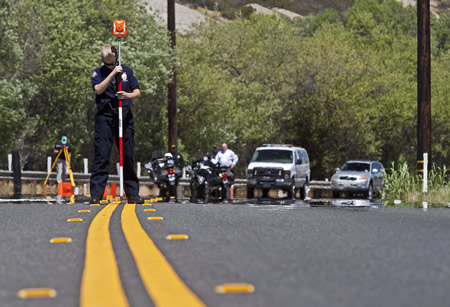A particularly violent crash and bang shattered a bucolic morning for Laguna Beach dog park patrons last August. Several people ran out to Laguna Canyon Road to see what happened as the rest converged on the gate amid confused canines, necks craned, awaiting feedback.
Minutes later one regular returned with the bad news. “Whoever owns that Lexus” parked north of the entrance, would not be driving home, he concluded. A woman let out an exclamation of dismay.

A 49-year old Aliso Viejo man driving northbound at about 50 miles an hour veered out of his lane and struck the Laguna Beach woman’s parked Lexus, as well as another unoccupied car, police said. The driver, who was uninjured, admitted to “looking down for a moment,” Capt. Jason Kravetz said, but was unaware of having drifted out of his lane until he felt the collision, which struck with such force it spun his vehicle around to face oncoming traffic.
This was just one of 572 accidents that occurred along the canyon road between Forest Avenue and El Toro Road from June 1, 2007, through Jan. 16, according to a report Kravetz presented to the Laguna Canyon Road Task Force last month.
The analysis involved 800 accident reports and broke the roadway into five zones, identifying the type and volume of accidents by segment.
During the nearly eight-year period, nine collisions involved pedestrians, including two fatalities: the death of Charles “Cowboy” Conwell, struck while crossing the road near ACT V in 2010, and that of Laguna College of Art & Design student Nina Fitzpatrick, who was struck in a crosswalk last April.
Four other people died in vehicle collisions on the road: a vehicle pulled into the path of an oncoming motorcycle, killing the rider in 2012; a Tesla racing a Mercedes collided head-on with a Honda in 2013, killing both occupants; and a drunk driver died after striking a parked car last May.
More than half the accidents, 56 percent, involved rear-end collisions, either caused by inattentive drivers or “courtesy” drivers, those stopping suddenly often for pedestrians at Laguna College of Art & Design or to allow cars to turn into the driveway at Anneliese’s School.
Most of the drivers who rammed the car ahead readily admitted to inattention, such as checking the GPS, but would not concede to looking at their phones, because they know it’s illegal, even though that was the more likely cause of distraction, Kravetz said.
While only 6 percent of the incidents involved cars hitting utility poles (37 in all), almost all of those occurred in Big Bend, the segment that claimed the worst accidents involving serious injuries, drunk drivers, high speeds and rollovers.
The zone from Forest Avenue to Milligan Drive, which includes the three art festivals, had the highest rate of collisions involving pedestrians, but the fewest collisions overall, with just 12 percent of the total.
The most collisions, 32 percent, occurred between Canyon Acres and the start of Big Bend. A quarter of those took place near the intersection of Canyon Acres, an area that also recorded the highest incidents of road rage, attributed to people refusing to merge or getting mad at drivers using the frontage road in front of the Sawdust to cheat the traffic.
The section of road from Stan Oaks to Anneliese’s School racked up the second most accidents, with 20 percent of all collisions, most occurring near the dog park.
Illegal passing (in the center lane near Canyon Acres and in the acceleration lane near the dog park) was a contributing factor in both of these high collision areas, as were illegal U-turns. Seeing stopped traffic ahead, frustrated northbound drivers near Canyon Acres attempted to turn back, while people exiting parking spaces near the dog park chose U-turns as a shortcut instead of driving north to a legal turnaround. Turning collisions, such as cars coming and going from the Canyon Club parking lot, also jacked the numbers up.
Kravetz pointed out that over the entire period of study there were 14 bicycle collisions, and not all of them involved cars. Sometimes riders fell off their bikes or ran into other cyclists. Others hit parked cars.
Only nine collisions occurred at Anneliese’s School, and all were in the outbound lanes. Kravetz attributed this relatively low number to the plastic barriers installed there prior to the period of study.
Barriers in the center lane near the dog park and in the turning lane past the Canyon Acres merge might discourage illegal U-turns and passing violations, Kravetz said, suggesting possible safety measures to the task force. Constraining exiting vehicles to right turns could improve traffic flow, but would congest the center lane, a dilemma best left to traffic engineers, he said.
The ideal solution for cyclists would be a paved off-road trail out of traffic, Kravetz said





[…] dangerous roads for motorcyclists in Orange County include Laguna Canyon Road and the Ortega Highway (S.R. 74). Both roads feature dangerous curves that invite impatient drivers […]
[…] 572 accidents between Forest Avenue and El Toro from June 2007 to January 2015, according to a 2015 report. That includes two pedestrian fatalities in 2010 and 2014, and vehicle collision fatalities in […]